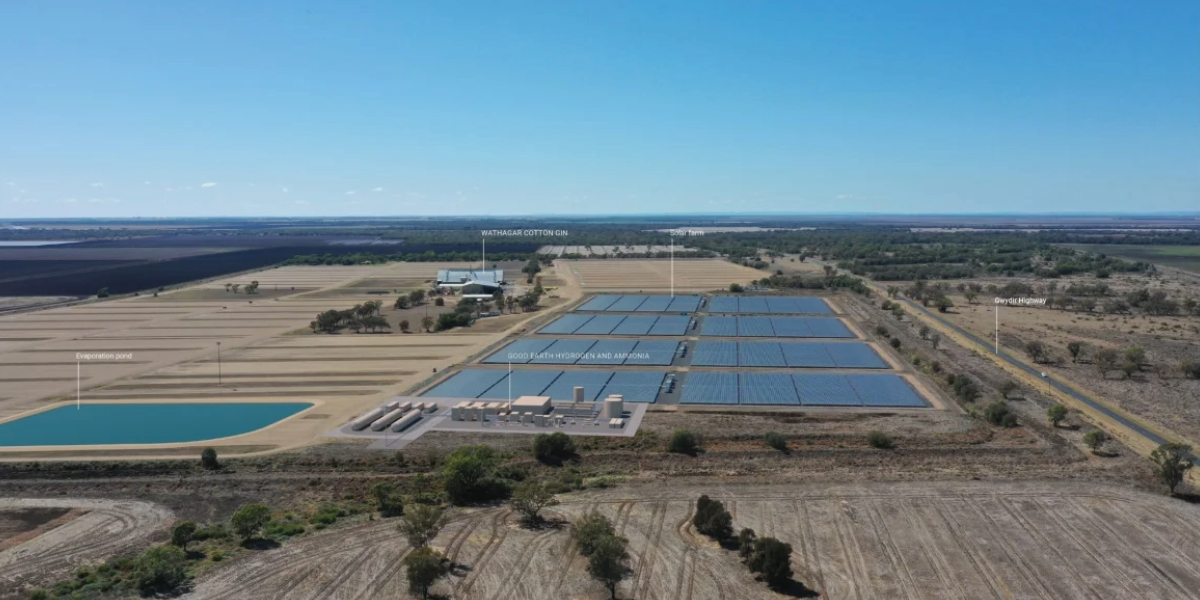A cotton farm near Moree is set to become a global pioneer in sustainable agriculture, with a green hydrogen and ammonia project backed by the NSW Government passing the next round of approvals and expected to be shovel ready soon.
Sundown Pastoral Company and Hiringa Energy have joined forces to deliver the Good Earth Green Hydrogen and Ammonia (GEGHA) project at the ‘Keytah’ property near Moree, home of the world’s first Good Earth Cotton farm. The initiative received funding through the NSW Hydrogen Strategy in 2023, and has now received approvals to move forward with the latest step in developing low-carbon solutions for the agriculture and freight industries.
The GEGHA project will integrate a solar-powered hydrogen and ammonia production facility with seasonal cotton ginning at the Wathagar site. The energy created will power ginning operations, supply the grid, and produce green hydrogen and ammonia to displace imported diesel, LPG and fertiliser.
Developed in partnership with hydrogen specialists Hiringa Energy, the project aims to establish a cleaner, more resilient local supply chain for fertiliser and fuel. It is also designed to help decarbonise some of the most challenging sectors in the region’s economy, including farming and freight.
“Hydrogen and green ammonia provide a unique opportunity to secure cost effective, clean, secure energy for power, heat, farm operations and transportation, as well as green fertilizers for agriculture – it is so important for us to be part of leading this change for the environment and our communities,” said Sundown Pastoral Co owner David Statham.
Together with his wife Danielle, Statham is behind the regenerative cotton program Good Earth Cotton and traceability platform FibreTrace. The couple have long championed sustainability and climate-positive farming practices.
“Agriculture is always adapting – as farmers we have adapted for generations. We have been measuring our emissions and reductions for the past five years.”
“There is an increasing demand for fibres that demonstrate a lower footprint and the GEGHA project allows us to further control the reduction of our emissions.”
The GEGHA project is being rolled out in stages, with the near-complete 9 MW solar installation at Wathagar to be followed by two more 9 MW modules, ultimately creating a 27 MW solar farm.
Once operational, the project is expected to produce around 45,000 MWh of energy annually – enough to power more than 4,000 homes – and manufacture 3,800 tonnes of anhydrous ammonia, replacing about 6,800 tonnes of imported urea. It will also produce sufficient low-carbon hydrogen to offset over 1.4 million litres of diesel.
Some of the hydrogen will be converted into ammonia for on-farm fertiliser use, while the rest will power motors, farm equipment and cotton drying facilities. Additional hydrogen will be made available for heavy transport refuelling in the Moree region, with Hiringa Energy driving the development of refuelling infrastructure.
According to Hiringa Energy, these types of projects demonstrate the practical applications of green hydrogen for agriculture and transport.
“The project provides a critical demonstration of how regional communities and industries can participate in and benefit from the hydrogen economy,” said Hiringa Energy CEO Andrew Clennett.
Minister for Climate Change and Energy Penny Sharpe said the GEGHA project was a step toward achieving the state’s renewable energy goals.
“Supporting projects like this in regional areas is exactly what our Hydrogen Hubs initiative is about,” Ms Sharpe said. “It shows how local innovation and collaboration can build energy resilience, reduce emissions, and drive economic growth.”
The NSW Government’s Hydrogen Strategy aims to build a thriving green hydrogen industry by supporting early-stage infrastructure and encouraging private investment. The Moree region has been identified as one of four priority locations for hydrogen hubs in the state.
The funding announcement and construction progress at Keytah marks a significant milestone in bringing the hydrogen economy to life in rural NSW, and signals a broader shift towards cleaner, smarter agriculture.
Don’t miss any of the important stories from around the region. Subscribe to our email list.

